Reporter / organizer: Jun Ueda(Biwa-ko Waterfowl and Wetland Center)/
Biodiversity Center of Japan, Ministry of the EnvironmentEBird Research
Date:@ 21th&22th January, 2012
Location:@ Biwa-ko Waterfowl and Wetland Center, Kohoku-cho, Nagahama-city, Shiga Prefecture, Japan
[Details]
1) Lake Biwa (Biwa-ko) is the largest lake in Japan. It was designated as a Ramsar Site in 1993. In 2008 Nishino-ko which is a marshy lake attached to Biwa-ko was added to the site. Biwa-ko Waterfowl and Wetland Center(BWWC) was opened by Ministry of the Environment in 1997 and has been supported by Nagahama City. BWWC and adjacent to Kohoku Wild-Bird Center(KWBC) are appealing the value of waterfowl and wetland, and are one of core base for wetland and tourism in Kohoku(the northern part of Biwa-ko ).
2) On 21th&22th January, 2012,@the meeting for gMonitoring Site 1000 Anatidae Surveyh@was held in BWWC. The meeting was@hosted by Biodiversity Center of Japan, Ministry of the Environment, and arranged by Bird Research.
3) Bewick's Swans and Middendorf's Bean Geese are regularly wintering in Kohoku, and widely observed by many tourists.@In the meeting there were lectures about their routes of wintering areas Hokuriku. The areas are located in Niigawa, Ishikawa, Fukui, which are all along Japan sea coast, and Shiga.
If there is heavy snowfall in Hokuriku area, Bewick's Swans and Middendorf's Bean Geese change their wintering sites to southern locations like Kohoku and Shiga. Regular wintering number of Bewick's Swans in Kohoku is about 300 to 600, but 905 swans were recorded in 2005-2006 winter because of heavy snowfall in Hokuriku.
4) In the 21th evening, at the special dinner party for tasting different types of lake fishes in cuisine Inn gUwoyoshih, participants of the meeting enjoyed to eat various kind of dishes. While we were enjoying the dinner, workers of Inn were telling us how to catch fish and cook them.
Those dishes are:Funa(crucian carp)fs sashimi, raw Funa dusted with their eggs, Hiuwo (juveniles of Ayu) fs chawan-mushi(Egg custard),@Fried wakasagi (Wakasagi tempura),Isaza(Gobies)fs tsukudani(boiled in soy sauce), EelfSukiyaki.
The best delicacy was Funazushi(fermented crucian carp). Funazushi, the specialty of Shiga prefecture, has an overpowering smell, which discourages many people from trying it. However, some people find sharp and vinegary taste is quite delicious at the first time.
5) At the excusion on 22th January, we went to watch the roosting site of Bewick's Swans in biotope rice paddy in Hayasaki, and their foraging site in rice paddy, a resting female Steller's Sea Eagle in Yamamoto-yama(Mt. Yamamoto). Thereafter we took a special fishing vessel, so called gLake Taxih. It was converted from a regular fishing boat to a sightseeing one. We watched the pelagic areas where the most number of waterfowls were recorded in Biwa-ko, and saw gErih,traditional fixed-shorenet in Biwa-ko. Fisherman, Masatomi Matsuoka explained how to catch fishes.
We found several hundred of the Baikal teals flying. At the moment, Mr. Yoshio Yamamoto confirmed two electric waves by his receiver. Those waves were came from transmitters which were attached to Baikal teals in Katano Kamoike pond. It is one of the Ramsar Site located in Ishikawa. This is the first time that Baikal teals from Kamoike pond were located in Lake Biwa.
WebsiteFhttp://www.biwa.ne.jp/~nio/eng/index_e.html
(in Japanese)
Photos:
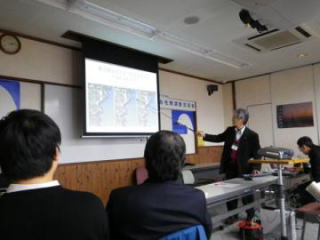
The meeting for gMonitoring Site 1000 Anatidae Surveyh
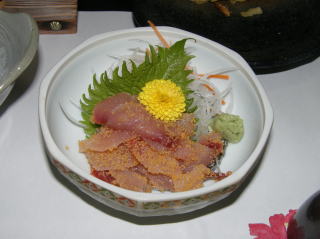
Funa(crucian carp)fs sashimi, raw Funa dusted with their eggs

Bewick's Swans foraging site in rice paddy
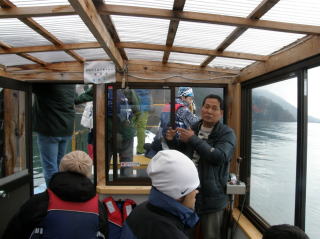
In "Lake Taxi", fisherman, Masatomi Matsuoka, explained how to catch fishes.
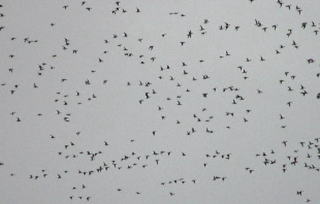
We found several hundred of the Baikal teals flying.
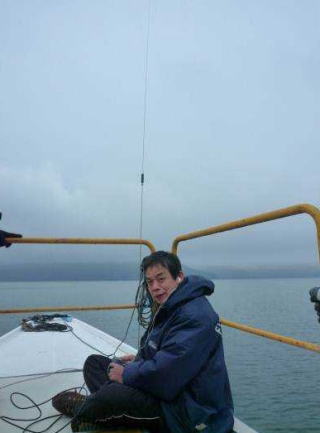
Mr. Yoshio Yamamoto confirmed two electric waves by his receiver.